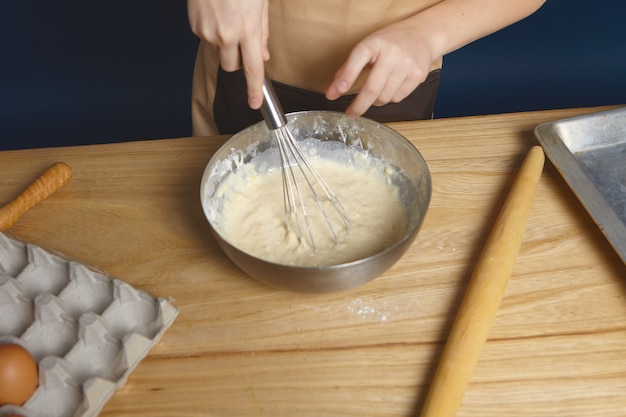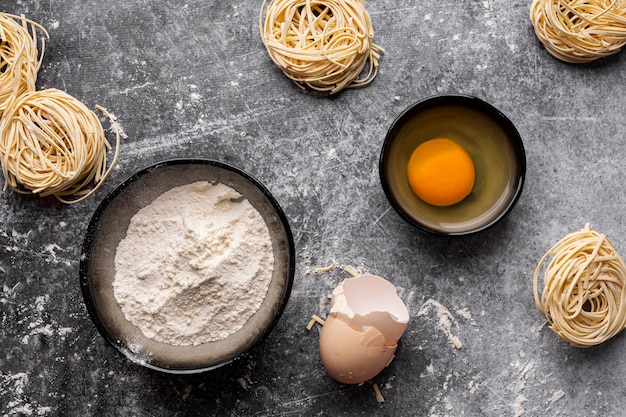(Part 1) Choosing the Right Vermicelli

Types of Vermicelli Noodles:
- Rice Vermicelli: This is the most common type, made from rice flour. It's thin, delicate, and has a slightly sweet flavour, making it perfect for light dishes like stir-fries, soups, and salads. Imagine it as the dainty ballerina of the noodle world.
- Bean Thread Vermicelli: Made from mung bean starch, this vermicelli is a bit thicker and chewier than rice vermicelli. Think of it as the dancer with a bit more pep in their step! It's often used in Vietnamese dishes like bun cha and bun bo hue, which pack a punch with their bold flavours.
- sweet potato Vermicelli: This is the health-conscious choice, made from sweet potato starch. It has a slightly earthy flavour, making it a great addition to Korean dishes like japchae.
- Glass Noodles: While not technically vermicelli, glass noodles are often confused for them. These transparent noodles are made from mung bean starch and are very delicate. They’re often used in stir-fries and soups, adding a cool, crunchy texture.
Tips for Choosing the Right Type:
- Consider the Dish: If you're making a light and delicate dish like a salad, rice vermicelli is your go-to. For a heartier dish like a stir-fry, bean thread vermicelli might be a better choice.
- Check the Ingredients: Make sure you're choosing a type of vermicelli that fits your dietary needs. For example, if you're gluten-free, rice or bean thread vermicelli are good options.
- Go for Fresh: Fresh vermicelli is always a winner! It has a better texture and flavour compared to dried vermicelli. But, if you're using dried vermicelli, make sure it's stored in a cool, dry place to prevent spoilage.
(Part 2) Preparing the Noodles

Soaking the Noodles (If Necessary):
Dried vermicelli needs a bit of pampering before cooking. Soak them in cold water for about 15-20 minutes. This softens the noodles and makes them easier to cook. Simply fill a large bowl with cold water, add the noodles, and let them soak. Once they’ve softened, drain them thoroughly before moving on to the next step.
Washing the Noodles:
Even fresh vermicelli can benefit from a quick rinse. Fill a bowl with cold water, add the noodles, and swish them around gently. This removes any excess starch or dust. Once rinsed, drain them thoroughly.
(Part 3) Cooking the Noodles

Boiling Method:
This is the most common and straightforward method. Fill a large pot with water and bring it to a rolling boil. Add the vermicelli noodles to the boiling water and cook for 2-3 minutes, or until they’re tender but still have a slight bite. Remember to stir the noodles occasionally to prevent them from sticking together. Once cooked, drain the noodles thoroughly in a colander.
Steaming Method:
If you're looking for a healthier way to cook vermicelli, steaming is your best bet. Place a steamer basket over a pot of boiling water. Add the vermicelli noodles to the steamer basket and steam for 3-5 minutes, or until they’re cooked through. This method helps preserve the noodles’ texture and flavour.
Microwave Method (For Fresh Vermicelli):
Yes, you can even cook vermicelli in the microwave! This is a quick and easy option, perfect for a small batch of noodles. Place the fresh vermicelli in a microwave-safe bowl and add a few tablespoons of water. Cover the bowl with a microwave-safe lid or plastic wrap and cook on high power for 1-2 minutes, or until the noodles are cooked through. Make sure to stir the noodles halfway through cooking to ensure even heating.
(Part 4) Checking for Doneness
It's crucial to know when your vermicelli is cooked to perfection. Here are a few signs to look out for:Signs of Doneness:
- Soft and Tender: The noodles should be soft and tender but not mushy. They should still have a slight bite to them.
- No White Core: If you’re cooking dried vermicelli, there should be no white core left in the centre of the noodles. This indicates that they’re cooked through.
- Translucent: The noodles should become translucent when cooked. You should be able to see through them slightly.
Overcooked Noodles:
Overcooked vermicelli can become mushy and lose its texture. If you think your noodles might be overcooked, drain them immediately and rinse them with cold water to stop the cooking process.
(Part 5) Draining and Cooling
Once the vermicelli is cooked, it's essential to drain and cool them properly to prevent them from sticking together.Draining:
After cooking, drain the noodles thoroughly in a colander. Shake the colander gently to remove any excess water. If you’re using a steamer, simply lift the steamer basket out of the pot of boiling water.
Cooling:
To prevent the noodles from sticking together, rinse them with cold water after draining. You can also toss them with a bit of vegetable oil or sesame oil to prevent them from sticking. This also adds a subtle flavour to the noodles.
(Part 6) Storing Cooked Vermicelli
If you've cooked more vermicelli than you need, don't fret! You can store the leftovers in the fridge for later use.Storing in the Fridge:
- Cool the Noodles: Let the cooked noodles cool completely before storing them in the fridge.
- Use a Container: Place the cooled noodles in an airtight container or resealable plastic bag.
- Store in the Fridge: Keep the noodles in the fridge for up to 3 days.
Reheating Cooked Vermicelli:
To reheat cooked vermicelli, you can simply add it to your desired dish and heat it through. You can also reheat it in the microwave for a few seconds, or by tossing it in a hot pan with a little bit of oil.
(Part 7) Vermicelli Recipes to Try
Now that you're a vermicelli pro, let's explore some delicious recipes you can make.Classic Vietnamese Pho:
A warm and comforting bowl of pho is the perfect way to use vermicelli noodles. It's a traditional Vietnamese noodle soup with a rich broth, tender slices of meat, and aromatic herbs. The vermicelli noodles soak up the delicious broth and provide a smooth texture. You can find many pho recipes online, or you can try your hand at making your own broth from scratch.
Spicy Thai Pad Thai:
Pad Thai is a popular street food in Thailand, and it's incredibly easy to make at home. This dish features stir-fried vermicelli noodles with tofu, chicken, or shrimp, along with a tangy and spicy peanut sauce. The noodles are cooked until they’re slightly crispy on the edges, adding a delightful textural contrast.
Korean Japchae:
Japchae is a delicious Korean stir-fry dish made with sweet potato vermicelli, vegetables, and sometimes meat. It's a perfect dish for special occasions or a light and satisfying meal. The vermicelli noodles are coated in a sweet and savory sauce and tossed with colorful vegetables, creating a stunning visual and flavorful experience. You can find various japchae recipes online, each with its own unique twist.
Vietnamese Bun Cha:
Bun Cha is another popular Vietnamese dish featuring vermicelli noodles. It consists of grilled pork patties served over vermicelli noodles with a delicious dipping sauce made with fish sauce, vinegar, and chili peppers. The vermicelli noodles soak up the dipping sauce, creating a flavorful and satisfying experience.
Filipino Pancit:
Pancit is a versatile Filipino noodle dish that comes in various styles. The vermicelli noodles are stir-fried with vegetables, meat, and a savory sauce. There are different types of pancit, each with its own unique flavors and ingredients.
(Part 8) FAQs
What’s the Difference Between Vermicelli and rice noodles?
Vermicelli and rice noodles are often used interchangeably, but there’s a slight difference. Vermicelli is generally thinner and more delicate than rice noodles. Rice noodles are often thicker and have a slightly chewier texture.
Can I Substitute Vermicelli with Other types of noodles?
Yes, you can substitute vermicelli with other types of noodles like rice noodles, egg noodles, or even spaghetti. Just keep in mind that the texture and flavour of the dish might be slightly different.
How Do I Prevent Vermicelli from Sticking Together?
To prevent vermicelli from sticking together, rinse them with cold water after draining and toss them with a bit of vegetable oil or sesame oil. You can also add them to your desired dish immediately after cooking.
How Long Can I Keep Cooked Vermicelli in the Fridge?
You can store cooked vermicelli in the fridge for up to 3 days. Make sure to store them in an airtight container or resealable plastic bag.
What Are Some Good Toppings for Vermicelli?
The possibilities are endless! You can top your vermicelli with fresh herbs like cilantro and mint, crunchy vegetables like bean sprouts and cucumbers, and a variety of sauces and dressings like peanut sauce, hoisin sauce, and chili oil.
(Part 9) My Personal Tips and Tricks
Now, here are a few tips and tricks I've learned from my own experience that you might find helpful:Don’t Overcook the Noodles:
Vermicelli noodles cook quickly, so don’t overcook them! If you’re cooking them in boiling water, make sure to check them after 2 minutes. They should be soft and tender, but not mushy.
Use a Large Pot:
When boiling vermicelli, make sure to use a large pot. This will help ensure that the noodles have enough room to cook evenly and prevent them from sticking together.
Don’t Rinse the Noodles If You’re Using Them for Soup:
If you’re using vermicelli noodles for soup, don’t rinse them after cooking. The starch from the noodles will help thicken the soup.
Experiment with Flavours:
Don’t be afraid to experiment with different flavours when cooking with vermicelli. You can add things like soy sauce, fish sauce, chili sauce, and garlic to your dishes.
Have Fun!
Most importantly, have fun with it! Cooking with vermicelli is a great way to explore different cuisines and create delicious dishes.
(Part 10) Conclusion
There you have it, folks! Everything you need to know about cooking perfect vermicelli noodles. Now go forth and whip up some delicious Asian-inspired dishes that will impress your friends and family. Remember, don’t be afraid to experiment and try new things. The possibilities are endless! And hey, if you ever have any questions or need some advice, don’t hesitate to reach out. I’m always happy to help. Happy cooking!Everyone is watching

Corn on the Cob: The Ultimate Guide to Perfectly Cooked Ears
Healthy MealsAh, corn on the cob. Just the name evokes images of sunny days, barbecues, and that sweet, juicy flavour that ...

Scallops: The Ultimate Guide to Perfect Cooking
Healthy MealsAh, scallops. Those delicate, sweet, and utterly delicious morsels of the sea. They hold a special place in my...

Spaghetti Squash: The Ultimate Guide to Cooking and Serving
Healthy MealsRemember that time you saw spaghetti squash at the supermarket, looking all bumpy and strange, and thought, "W...

Salmon Cooking Times: Perfect Guide for Every Recipe
Healthy MealsLet me tell you, cooking salmon is an art form. It's all about getting that perfect balance: juicy and tender,...

Ham Cooking Time: How Long to Bake, Smoke, or Boil a Delicious Ham
Healthy MealsAh, ham. It's a classic, isn't it? A real crowd-pleaser, especially around holidays. And when done right, it'...
